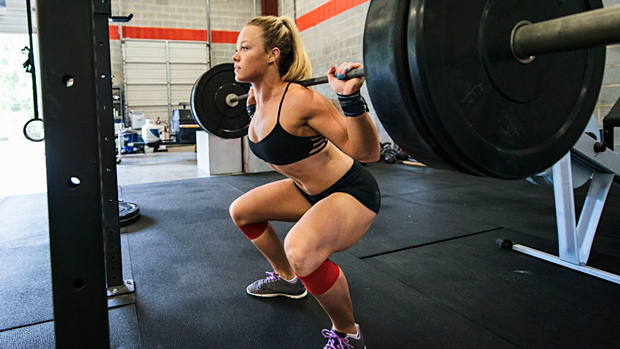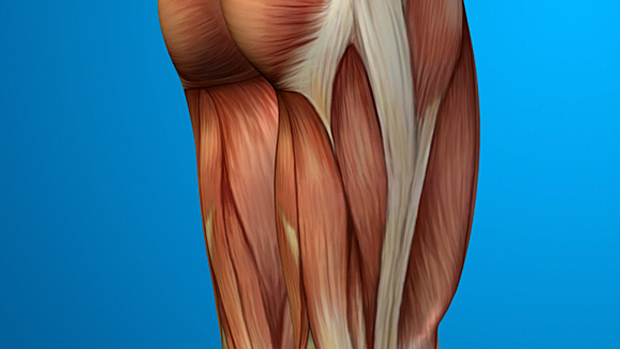You know the guy who floats around the gym nit-picking everybody's technique? The guy who offers constructive criticism without being constructive? Well, we got sick of listening to his pseudo-knowledge about leg training, so we had Alwyn Cosgrove respond to some of the most common "tips" you hear.
Myths
- "When doing leg presses, don't go more than half-way down."
- "When squatting, don't go below parallel."
Real-World Response
Have you ever watched kids learn to stand? They begin in a full squat. In fact, the fetal position is a full squat. That's how your knee actually developed – in the full squat position.

Don't come back at me saying that a fetal position isn't loaded. That statement actually proves my point. It's not the position itself that's dangerous. If you're an idiot and don't know how to load properly, then we have big problems.
Ask any orthopedic surgeon or physical therapist at what degree of knee-bend one performs the "drawer test?" It's at 90 degrees. In this position, the knee joint is most unstable. If you're trying to assess the integrity of the ligaments, you want minimal interference from other structures.

Bend the knee to full flexion and check how much the tibia moves on the femur anteriorly or posteriorly. It's very little. However, do the same test at 90 degrees of flexion and you'll get considerably more movement.
You can imagine how much force is on the knee ligaments if the athlete descends with a weight and then at the most unstable point (90 degrees), reverses momentum and accelerates in the opposite direction. Couple this with the fact that nearly everyone is capable of squatting more weight to parallel than to the full squat position, and you set your body up for a problem.
Scientific Response
Squatting to parallel with legs bent at 90 degrees not only makes the exercise less effective, but increases the risk of injury. By not squatting through a full range of motion, you can't maintain proper lumbosacral body mechanics.
When performing the squat, the sacrum undergoes a process known as nutation. It tilts forward relative to the two ilia on either side of it. At approximately 90 degrees of knee bend, the sacrum tilts back in a process known as counternutation. These two functions, nutation and counternutation, basically describe the movement at the sacroiliac (SI) joint.

However, proper SI joint mechanics help to ensure optimal functioning of the rest of the spine. For example, some literature links SI dysfunction with lower back pain in up to 80% of cases.
In order to perform a full squat, flexibility and range of motion must be maintained in the lumbar spine and SI joint, as well as in muscles such as the iliopsoas, hip external rotators, piriformis, and gemelli.
If a client can't squat past 90 degrees of knee bend without their heels raising or their body bending excessively forward at the waist, but they can squat all the way to the floor while holding onto something, we know there are muscle imbalances and stability issues around the pelvic/lumbosacral region as opposed to a knee or ankle dysfunction.
Additionally, improper pelvic, hip, and/or lumbosacral mechanics could manifest down the kinetic chain as recurring knee or ankle problems. Thus, regular performance of the full squat offers a "screen" of the athlete's pelvic and lumbosacral flexibility. This could prevent injury or muscle imbalances long before they become chronic.

As far as studies go, Salem and Powers (2001) looked at patellofemoral joint kinetics in female collegiate athletes at three different depths of knee flexion – 70 degrees (above parallel), 90 degrees (at parallel), and 110 degrees (below parallel).
The researchers found that "...peak knee extensor moment, patellofemoral joint reaction force and patellofemoral joint stress did not vary significantly between the three squatting trials..." There was no support for the idea that squatting below parallel increased stress on the patellofemoral joint.
Myth
- "Don't let your knee pass your foot during lunges."
Real-World Response
This one is really easy. My answer is, what about the other knee? In a lunge, it's apparently too dangerous for the knee of the front leg to extend past the toes. Meanwhile the knee of the back leg is past the toes the whole time.
I've had people respond by saying that there's no load on the back leg during a lunge. Okay then, put 135 pounds on your back and go down to the bottom of a lunge. Now lift your back foot off the floor. I rest my case.
Scientific Response
When talking about knees going forward, one study jumps out. Fry, Smith, and Schilling (2003) examined joint kinetics during back squats under two conditions.
The first condition placed a board in front of the participants' shins, which restricted forward displacement of the knee. In the second condition, movement wasn't restricted at all. They squatted normally and the knees were allowed to pass the toes.
The researchers found that restricting the forward excursion of the knees during the squat increased anterior lean of the trunk and promoted an increased "internal angle at the knees and ankles."
The results showed a 22% decrease in knee torque and a 1070% increase in hip torque! That stress has to go somewhere. Keeping the knees behind the toes definitely reduces the forces on the knee, but those forces were transferred more than tenfold to the hips and lower back.
Obviously this study was in regard to squatting. However, the knee angle in a lunge would be similar and we could expect similar findings.
- For strength and joint health, using the full range of motion on squats is more beneficial than squatting to parallel.
- Squatting deep isn't any more hazardous to the knees than squatting shallow. So stop being a puss and go low.
- Performing an unloaded, bodyweight squat is an excellent assessment tool and can be used often as a "body check-up."
- Keeping your knees behind your toes when squatting or lunging is a little better for your knees, but much, much worse for your hips and lower back.




